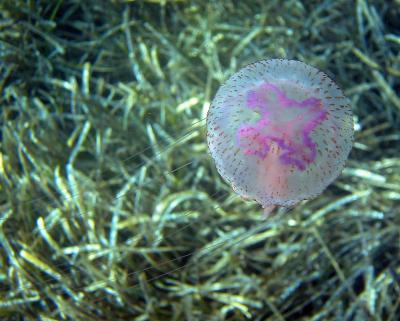Purple-striped Jellies Abundant near Barrier Islands
Fri, 06/15/2012 - 05:28pm | By: Martha Brown

Pelagia noctiluca, a relative of the common sea nettle, has been found in large numbers near the barrier islands in recent days. Commonly called the purple-striped jellyfish, the species is found in all warm and temperate oceans. While more common offshore, winds and circulation patterns may periodically move swarms of these sea jellies into nearshore waters.
John Anderson, a research biologist in the Fisheries Center at The University of Southern Mississippi's Gulf Coast Research Laboratory (GCRL), first collected a few specimens of the purple striped jellyfish offshore several miles south of Mississippi during a trawl survey on May 30.
By June, specimens were noted on the north side of Horn Island around the grass beds and swarms were observed south of the islands. Anderson noted that the jellyfish seemed to be accumulating near the passes and that some of the jellies were found mid-Sound.
Harriet Perry, GCRL senior research biologist, noted that while several studies have noted the presence of these sea jellies in local waters, large swarms are not common in Mississippi. Like the sea nettle, they have stinging nematocyst cells which they use in food capture and defense. They feed on large zooplankton and fish eggs.
Swimmers should be aware that the sting of the jellyfish can be painful, and should avoid waters where they are observed. The organisms are pink to purple in color and range in bell diameter from 1 to 3 inches, with very long tentacles.
The mission of the Gulf Coast Research Laboratory, Mississippi's marine laboratory, is scientific discovery related to coastal and marine resources, development of new marine technologies, and the education of future scientists and citizens. For more information about research and programs at GCRL, visit www.usm.edu/gcrl